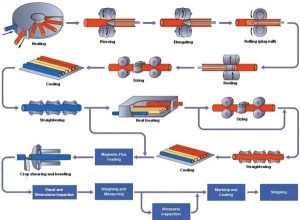How is seamless steel pipe produced?
Date:2019-05-09 View(s):1619 Tag:How is seamless steel pipe produced?
1. Introduction to seamless steel pipe
The seamless steel pipe is a circular, square, rectangular steel with a hollow section and no seams around it. The seamless steel pipe is formed by perforating a steel ingot or a solid tube blank, and then hot rolled, cold rolled or cold drawn. The seamless steel pipe has a hollow section and is used as a pipe for conveying fluid. Compared with a solid steel such as round steel, the steel pipe has a lighter weight when it has the same bending and torsional strength, and is an economical section steel which is widely used for manufacturing structures. Parts and mechanical parts, such as steel scaffolding for oil drills.
2. History of seamless steel pipe development
Seamless steel pipe production has a history of nearly 100 years. The German Mannesmann brothers first invented the two-roll cross-rolling piercing machine in 1885, and invented the cycle rolling mill in 1891. In 1903, the Swiss Ritteriefel invented the automatic pipe rolling machine (also called the head-rolling pipe). Machines, and later various types of extension machines such as continuous tube rolling mills and pipe jacking machines, began to form a modern seamless steel pipe industry. In the 1930s, the quality of the steel pipe was improved due to the use of a three-roll mill, an extruder, and a periodic cold-rolled pipe mill. In the 1960s, due to the improvement of continuous rolling mills, the emergence of three-roller punching machines, especially the application of tension reducing machines and continuous casting blanks, increased production efficiency and enhanced the ability of seamless pipes to compete with welded pipes. In the 1970s, seamless pipes and welded pipes were moving in parallel, and the world’s steel pipe production increased at a rate of more than 5% per year. After 1953, China attached great importance to the development of seamless steel pipe industry, and has initially formed a production system for rolling various large, medium and small pipes. Copper pipes are generally also used in the ingot blank rolling piercing, rolling mill rolling, coil stretching process.
3. Use and classification of seamless steel tubes
use:
Seamless steel pipe is an economical section steel, which has a very important position in the national economy and is widely used in petroleum, chemical, boiler, power station, shipbuilding, machinery manufacturing, automobile, aviation, aerospace, energy, geology, construction and military. each department.
classification:
1 according to the shape of the section: circular section tube, profiled section tube
2 according to the material: carbon steel pipe, alloy steel pipe, stainless steel pipe, composite pipe
3 according to the connection method: threaded connecting pipe, welded pipe
4 according to the production mode: hot rolling (squeezing, top, expansion) tube, cold rolling (pull) tube
5 according to the purpose: boiler tube, oil well tube, line tube, structural tube, fertilizer tube…
4. Production process of seamless steel pipe
1 Main production process of hot-rolled seamless steel pipe (main inspection process):
Tube blank preparation and inspection → tube billet heating → perforation → rolling tube → waste tube reheating → fixed (reduced) diameter → heat treatment → finished tube straightening → finishing → inspection (non-destructive, physical and chemical, Taiwan inspection) → storage
2 cold rolling (drawing) seamless steel pipe main production process
Blank preparation → pickling lubrication → cold rolling (pull) → heat treatment → straightening → finishing → inspection 5, hot rolling seamless steel pipe production process flow chart is as follows:

